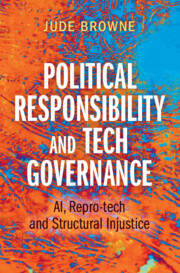Book contents
- Political Responsibility & Tech Governance
- Political Responsibility & Tech Governance
- Copyright page
- Dedication
- Epigraph
- Contents
- Preface
- Acknowledgements
- Introduction
- Chapter 1 The Problem of Structural Injustice
- Chapter 2 Artificial Intelligence and Ground Truth
- Chapter 3 Repro-tech and the Genetic Supermarket
- Chapter 4 Putting the Public into the Public Body
- Chapter 5 Conclusion
- Appendix Legal, Moral and Structural Actions, Injustices and Responsibilities
- References
- Index
Chapter 1 - The Problem of Structural Injustice
Where No One Is Liable, Who Is Responsible?
Published online by Cambridge University Press: 21 February 2025
- Political Responsibility & Tech Governance
- Political Responsibility & Tech Governance
- Copyright page
- Dedication
- Epigraph
- Contents
- Preface
- Acknowledgements
- Introduction
- Chapter 1 The Problem of Structural Injustice
- Chapter 2 Artificial Intelligence and Ground Truth
- Chapter 3 Repro-tech and the Genetic Supermarket
- Chapter 4 Putting the Public into the Public Body
- Chapter 5 Conclusion
- Appendix Legal, Moral and Structural Actions, Injustices and Responsibilities
- References
- Index
Summary
In order to set the ground for my arguments later in this book on the structural dynamics of AI and Repro-tech, I begin with Iris Marion Young’s political theory, not because she worked on the governance of technology but because her work on structural injustice enables the exploration of the limits of a politics grounded in liability, which is where most of the thinking on tech governance currently resides. I take time in Chapter 1 to consider the ways in which, influenced by her critical engagement with the work of Hannah Arendt, Young leads us to the question of ‘where nobody is liable, who is responsible?’ This structural question acts as a central theme of the book in the specific context of technology governance beyond liability and I use it to develop my own particular interpretation of structural injustice, in part based on my critical exploration of the work of Young’s critics. My interpretation of Young’s work is unusual in that I see substantial political merit in actively sharpening the distinction between liability and structural injustice. This approach goes against the grain of current thinking on structural injustice.
- Type
- Chapter
- Information
- Political Responsibility and Tech GovernanceAI, Repro-tech and Structural Injustice, pp. 12 - 48Publisher: Cambridge University PressPrint publication year: 2025

